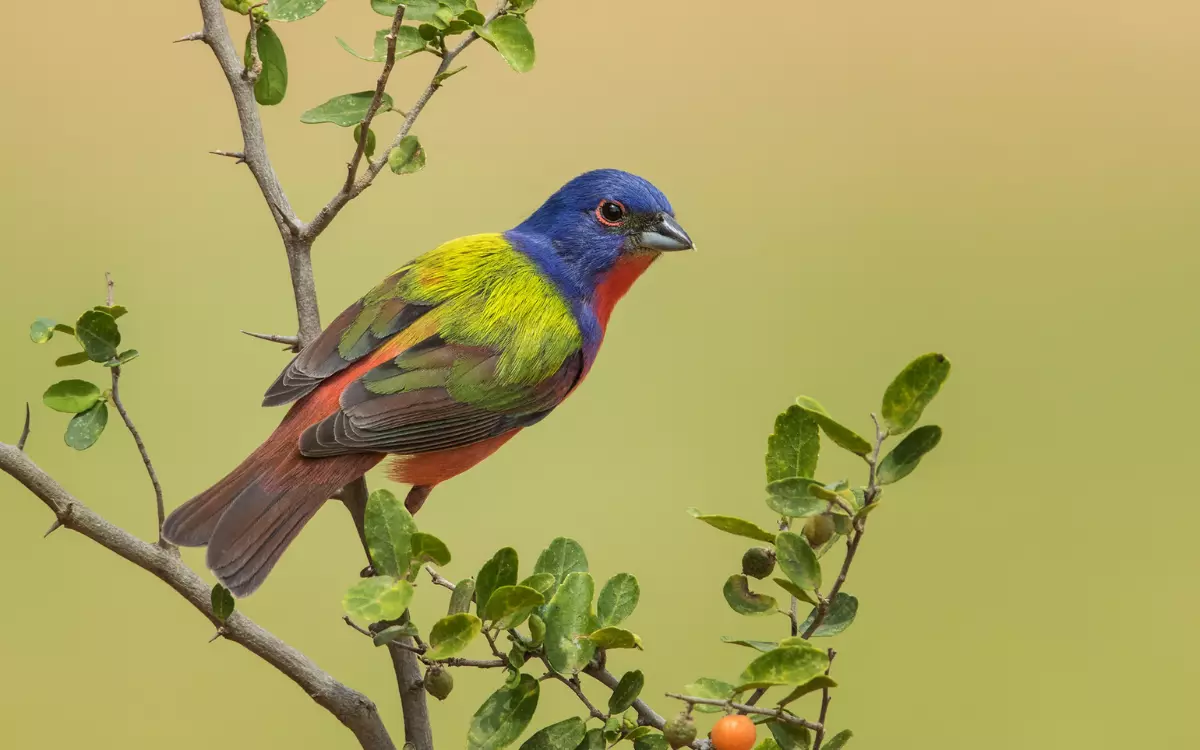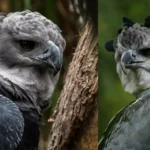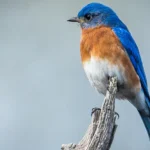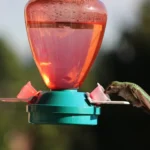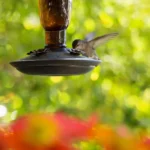Engage yourself in the shining spectacle of Red, Orange, & Yellow Birds in New Hampshire. Today we collected 10 Red, 7 Orange, & 27 Yellow Birds with their beautiful images, Info, & ID.
10 Red Birds in New Hampshire:
1.House Finch – Haemorhous mexicanus:

The House Finch is a familiar sight in New Hampshire, with its cheerful red plumage that adorns both males and females. This finch is a true survivor, adapting well to urban environments and human presence.
The male’s rosy red throat and forehead make it a standout among backyard visitors. House Finches lay between 2 to 6 eggs per clutch and typically spend a considerable amount of time throughout the year in New Hampshire, thanks to its adaptability to cold climates.
- Length: 5 – 6 in(12.5 – 15cm)
- Weight:0.6-0.9 oz (16-27 g)
- Wingspan: 8 -10 in (20 – 25 cm)
2.Purple Finch – Haemorhous purpureus:

The Purple Finch boasts a stunning raspberry hue that graces its plumage, making it a sought-after sight for birdwatchers. This species is known for its sweet and melodious song, which adds a musical element to the New Hampshire landscape. Purple Finches lay around 3 to 5 eggs per nest and, like the House Finch, are a common presence in the state year-round, even during colder months.
- Length: 4.7–6.3 in (12–16 cm)
- Weight: 0.63–1.13 oz (18–32 g)
- Wingspan: 10 in (25.4 cm)
3.Red Crossbill – Loxia curvirostra:
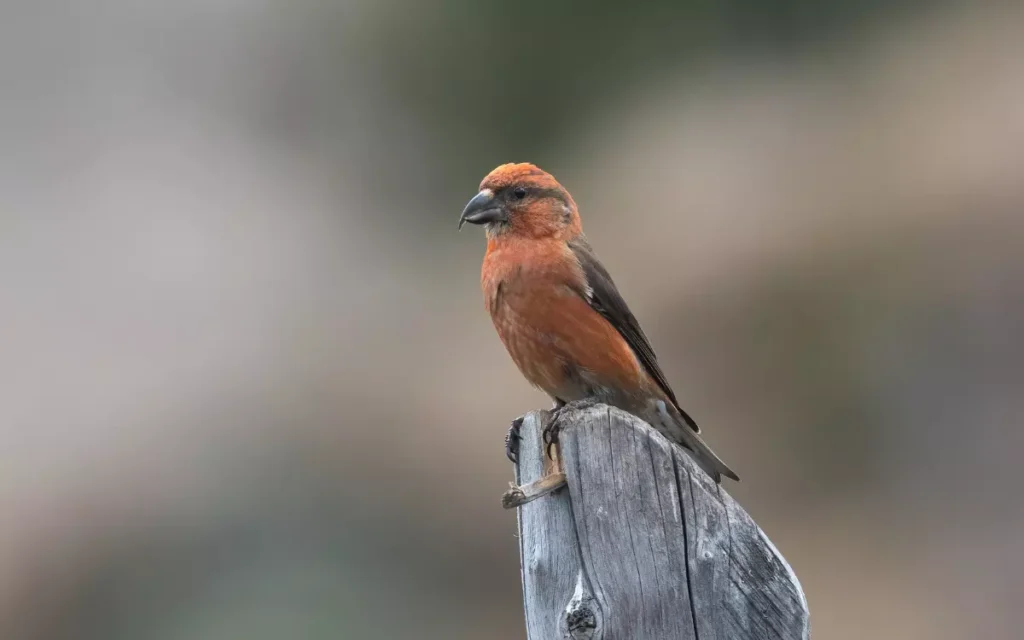
The Red Crossbill is known for its peculiar bill, which is crossed at the tips and specialized for extracting seeds from conifer cones. Their fiery red plumage adds a burst of color to the coniferous forests they inhabit. While they can breed throughout the year, their nesting habits are highly influenced by food availability, and they can be found year-round in New Hampshire.
- Length: 7.87 in (20 cm)
- Weight: 1.41 – 1.86 oz (40-53 gm)
- Wingspan: 10.62 – 11.41 in ( 27–29 cm)
4. White-winged Crossbill – Loxia leucoptera:
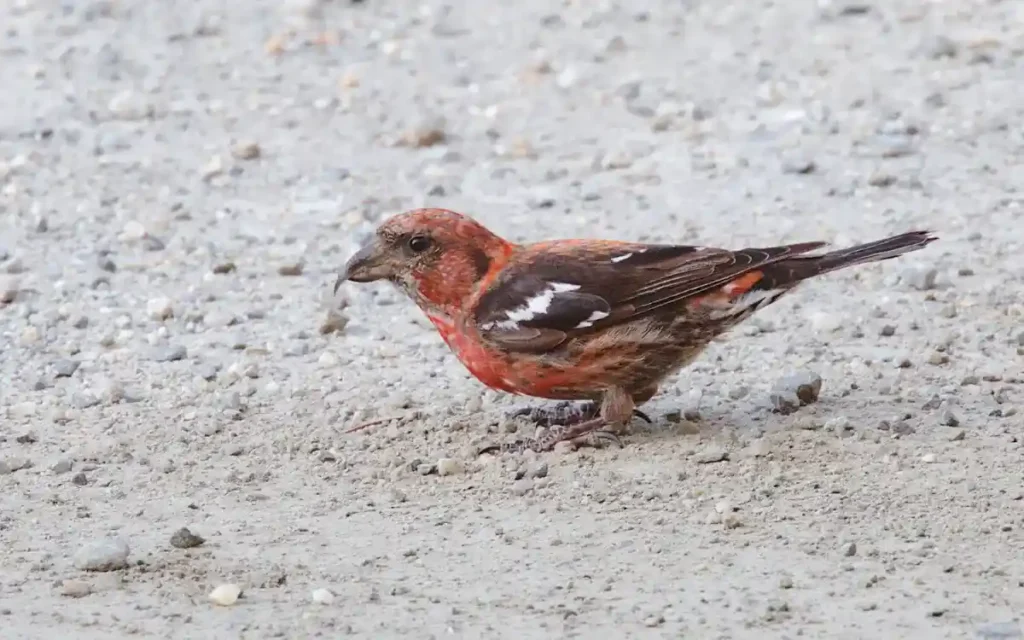
Distinct from the Red Crossbill, the White-winged Crossbill showcases striking white wingbars against its red body. These crossbills are adept at using their unique bills to extract seeds from cones,
making them well-suited for life in the coniferous forests of New Hampshire. The breeding habits and annual presence of White-winged Crossbills in the state are closely connected to cone crops.
- Length: 5.9-6.7 in (15-17 cm)
- Weight: 0.8-0.9 oz (24-26 gm)
- Wingspan: 10.2-11.0 in (26-28 cm)
5.Pine Grosbeak – Pinicola enucleator:
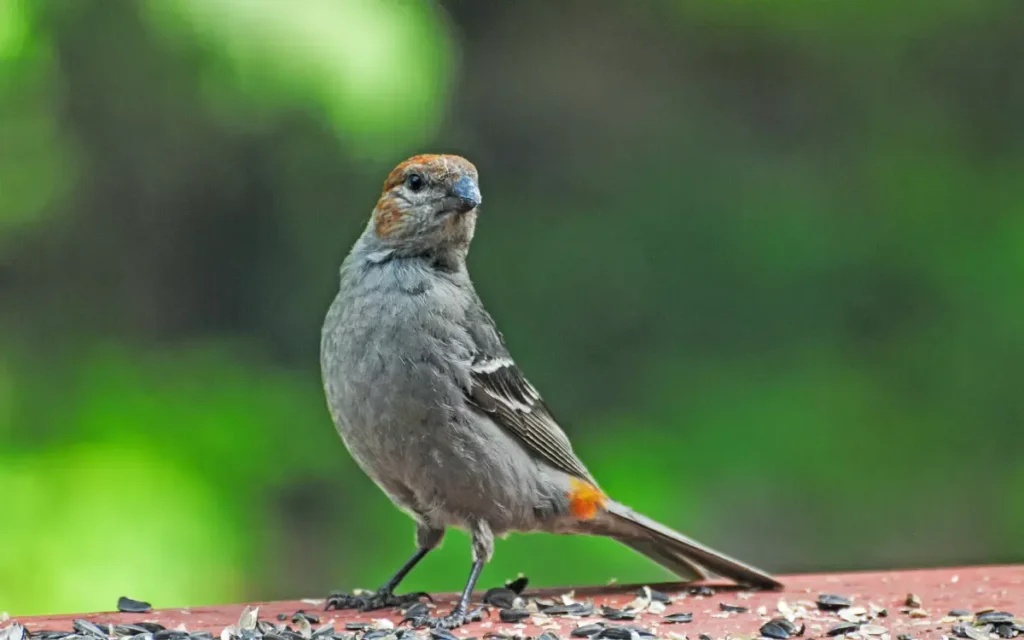
The Pine Grosbeak graces New Hampshire with its gentle demeanor and beautiful combination of red and gray plumage.
These birds are often found in small flocks, foraging for seeds and berries. Pine Grosbeaks generally lay between 2 to 5 eggs per clutch, and their presence in the state is more prominent during the winter months.
- Length: 7.9 – 10.0 in ( 20 – 25.5 cm )
- Weight: 1.8 – 2.8 oz ( 52 – 78 gm )
- Wingspan: 13.0 in (33 cm)
6.Northern Cardinal – Cardinalis cardinalis:
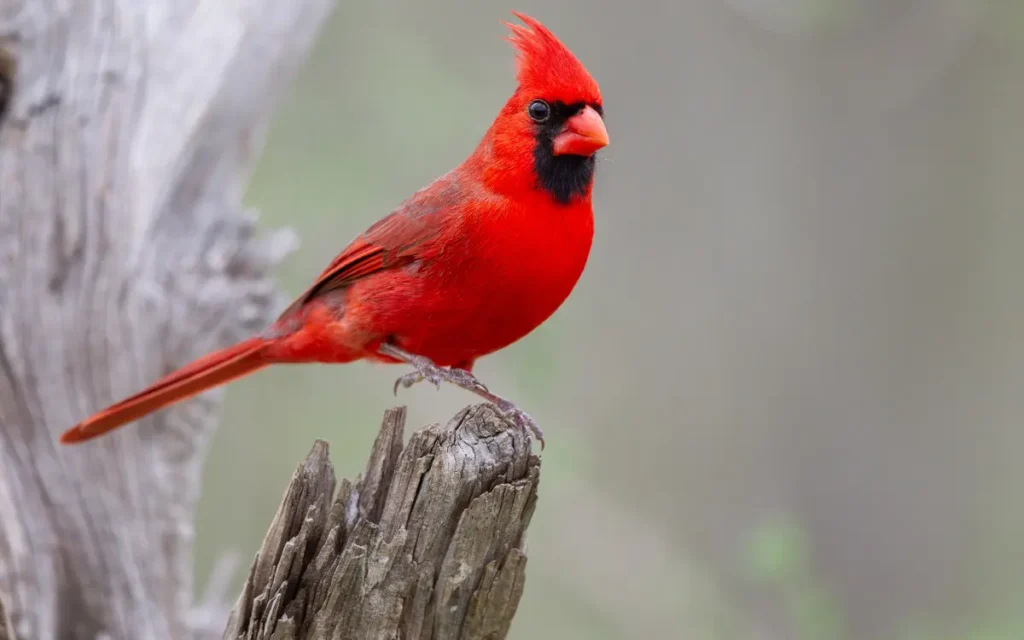
The Northern Cardinal, with its iconic crest and vibrant red plumage, is a symbol of beauty and resilience. Both males and females don the striking red color, with the male’s bright hue standing out against winter landscapes.
They are known for their melodious songs and often choose dense shrubs for nesting sites. Northern Cardinals usually lay 2 to 4 eggs per brood and are permanent residents in New Hampshire.
- Length: 8.3–9.3 in (21–23.5 cm)
- Weight: 1.19–2.29 oz (33.6–65 gm)
- Wingspan: 9.8–12.2 in (25–31 cm).
7. Summer Tanager – Piranga rubra:
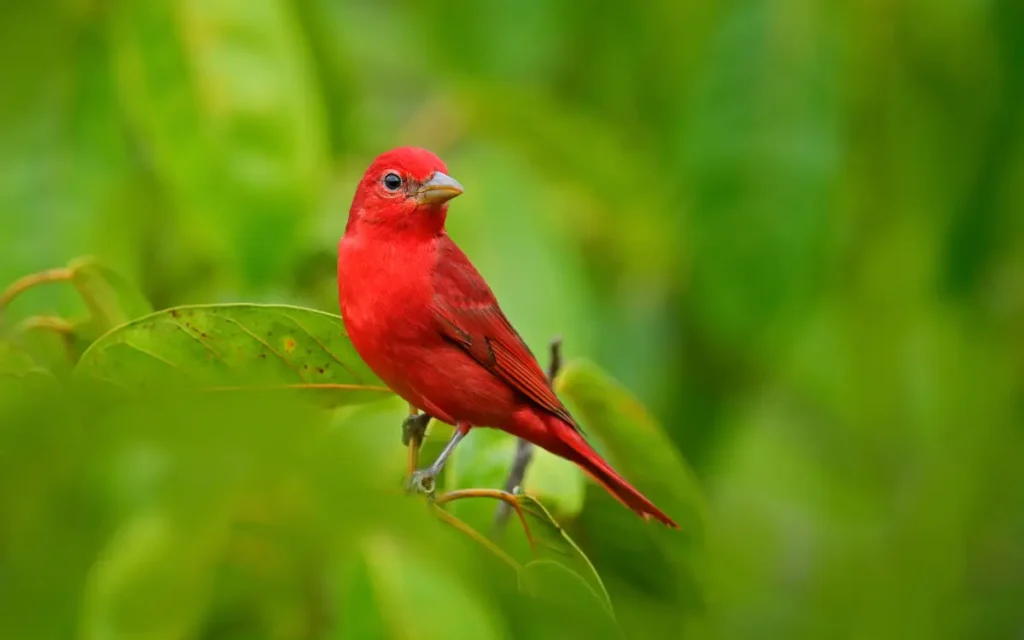
The Summer Tanager, as its name suggests, brings a splash of summer to New Hampshire with its stunning red plumage. While it’s a relatively rare visitor to the state, its vibrant color and sweet song make it a delight for bird enthusiasts lucky enough to spot one. Summer Tanagers lay around 2 to 4 eggs per clutch, and their presence in New Hampshire is most notable during the warmer months.
- Length: 6.7 in (17 cm)
- Weight: 1.1 oz (30 gm)
- Wingspan: 11.02 – 11.81 in (28 – 30 cm)
8.Rose-breasted Grosbeak – Pheucticus ludovicianus:
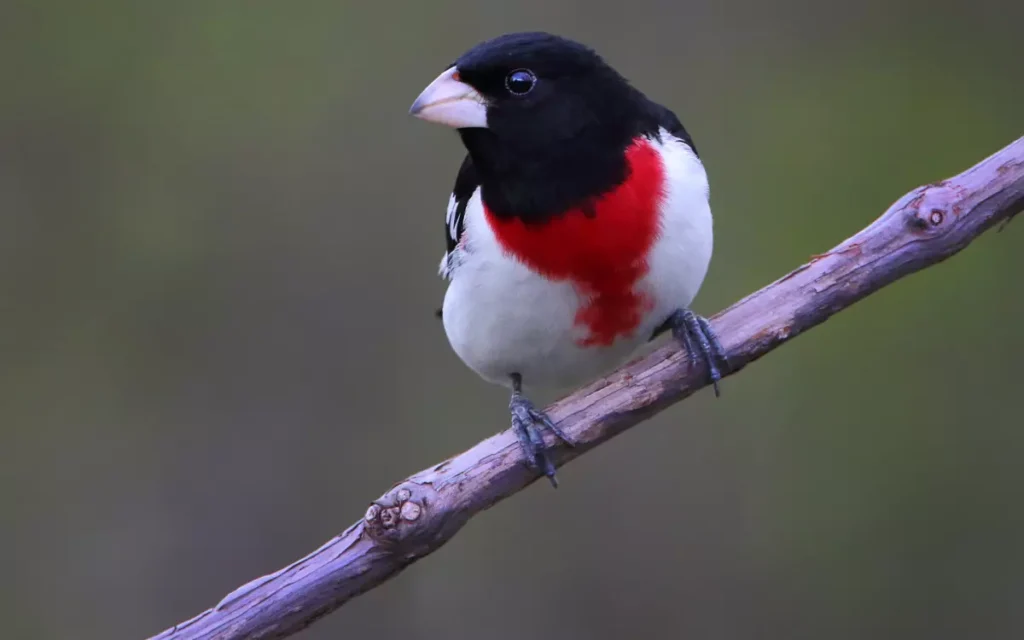
The Rose-breasted Grosbeak is a true gem of New Hampshire’s bird community, with its bold black and white patterns complemented by its rosy-red chest.
These grosbeaks have a distinctive song that adds to the symphony of the state’s woodlands. They lay around 3 to 5 eggs per clutch and are often spotted during their breeding season, making the most of the state’s favorable conditions.
- Length: 7.1–8.7 in (18–22 cm )
- Weight: 1.2–2.3 oz ( 35–65 gm)
- Wingspan: 11–13 in (29–33 cm)
9.Painted Bunting – Passerina ciris:
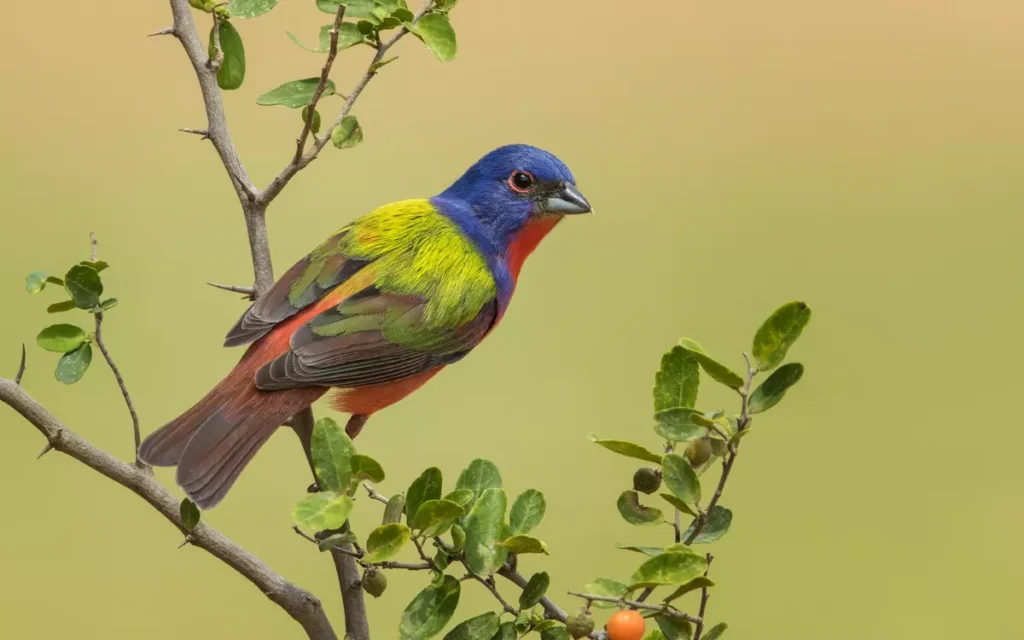
The Painted Bunting, though a rare visitor to New Hampshire, is an unforgettable sight with its breathtaking combination of vibrant colors. This bird’s plumage resembles a masterpiece of nature, featuring shades of blue, green, and red. Painted Buntings lay around 3 to 4 eggs per clutch, and their appearances in the state are like precious gifts to birdwatchers.
- Length: 4.7–5.5 in (12–14 cm),
- Weight: 0.46–0.67 oz(13–19 gm )
- Wingspan: 8.3–9.1 in ( 21–23 cm)
10.Common Redpoll – Acanthis flammea:

The Common Redpoll, a true winter visitor to New Hampshire, brings its charming red crown and rosy chest to brighten the snowy scenery.
These small birds are uniquely adapted to survive in cold conditions, thanks to their specialized beaks and extra fluffy plumage. They typically lay 3 to 7 eggs and spend the winter months in the state before migrating to their breeding grounds.
- Length: 4.5 – 5.5 in (11.5 – 14 cm )
- Weight: 0.42 – 0.56 oz (12 – 16 gm)
- Wingspan: 7.5 – 8.7 in (19 – 22 cm)
7 Orange Birds in New Hampshire
1.Red-breasted Nuthatch – Sitta canadensis:

The Red-breasted Nuthatch is a charming little bird that brings its lively personality to the New Hampshire forests.
With its eye-catching orange underparts and distinct black stripe across its eyes, this nuthatch is a true gem. In New Hampshire, these birds typically lay a clutch of 4 to 7 eggs during the breeding season.
They are known for their acrobatic behaviors as they explore tree trunks and branches, often upside-down, in search of insects and seeds.
- Length: Around 4.3 in (11 cm)
- Weight: 0.3-0.5 oz (8-13 g)
- Wingspan: 7.1-7.9 in (18-20 cm)
2.American Redstart – Setophaga ruticilla:

The American Redstart is a migratory warbler that graces New Hampshire with its vibrant presence. Males sport a striking combination of jet-black feathers and fiery orange patches on their wings, tail, and sides.
These birds are known for their unique foraging behavior, flitting their wings to startle insects from foliage and catching them mid-air. In New Hampshire, American Redstarts lay about 3 to 5 eggs, contributing to the next generation of these remarkable songbirds.
- Length: 4.3-5.1 in (11-13 cm)
- Weight: 0.2-0.3 oz (6-9 g)
- Wingspan: 6.3-7.5 in (16-19 cm)
3.Barn Swallow – Hirundo rustica:

The Barn Swallow is a familiar sight in New Hampshire’s rural landscapes. With its deeply forked tail and rust-colored throat and forehead, this bird is hard to miss.
These agile fliers are known for their impressive aerial acrobatics as they swoop and dive to catch flying insects. Barn Swallows are known to lay 3 to 7 eggs in their cup-shaped nests, which they construct with mud and lined with feathers.
- Length: 5.9-7.5 in (15-19 cm)
- Weight: 0.6-0.7 oz (17-20 g)
- Wingspan: 11.4-12.6 in (29-32 cm)
4.Baltimore Oriole – Icterus galbula:
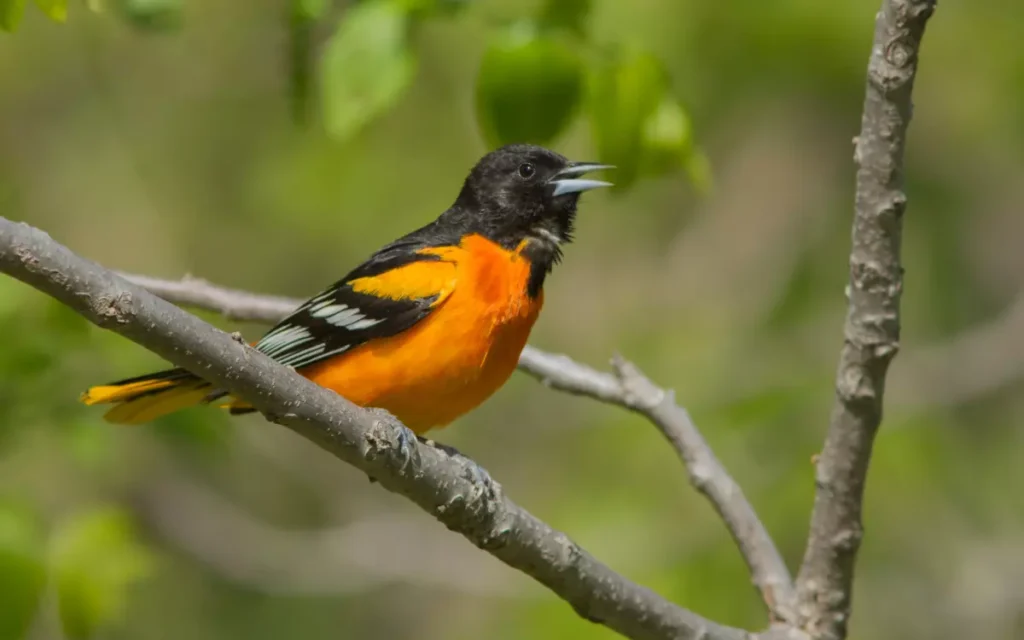
The Baltimore Oriole is a true symbol of elegance with its bright orange plumage and contrasting black markings. These birds bring their melodious songs to New Hampshire during the breeding season.
The female orioles are often more subtly colored, with a pale orange hue. These skilled nest builders create intricate hanging nests, weaving plant fibers to create a pouch-like structure. Baltimore Orioles typically lay 3 to 7 eggs per clutch.
- Length: 6.7–8.7 in (17–22 cm)
- Weight: 0.79 – 1.48 oz (22.3 – 42 gm )
- Wingspan: 9.1–12.6 in (23–32 cm)
5.Wood Thrush – Hylocichla mustelina:

The Wood Thrush adds its enchanting song to New Hampshire’s woodlands. While not entirely orange, its warm russet-brown back and speckled white underparts give it a charming appearance.
These thrushes are known for their ethereal flute-like songs that fill the forest during the breeding season. In New Hampshire, Wood Thrushes lay around 3 to 4 eggs in their cup-shaped nests, which are carefully concealed among dense vegetation.
- Length: 7.5-8.3 in (19-21 cm)
- Weight: 1.4-1.8 oz (40-50 g)
- Wingspan: 11.8-13.4 in (30-34 cm)
6.Eastern Towhee – Pipilo erythrophthalmus:

The Eastern Towhee brings its bold personality to New Hampshire’s shrubby habitats. With its striking black upperparts, orange sides, and white belly, this bird is a study in contrasts.
Eastern Towhees are known for their distinctive “drink-your-tea” song. They typically lay 2 to 6 eggs in their nests, which are often well-hidden on the ground beneath thick vegetation.
- Length: 6.8 – 9.1 in (17.3 – 23 cm)
- Weight: 1.1 – 1.9 oz (32 – 53 g m)
- Wingspan: 7.9–11.8 in ( 20–30 cm )
7. Scarlet Tanager – Piranga olivacea:
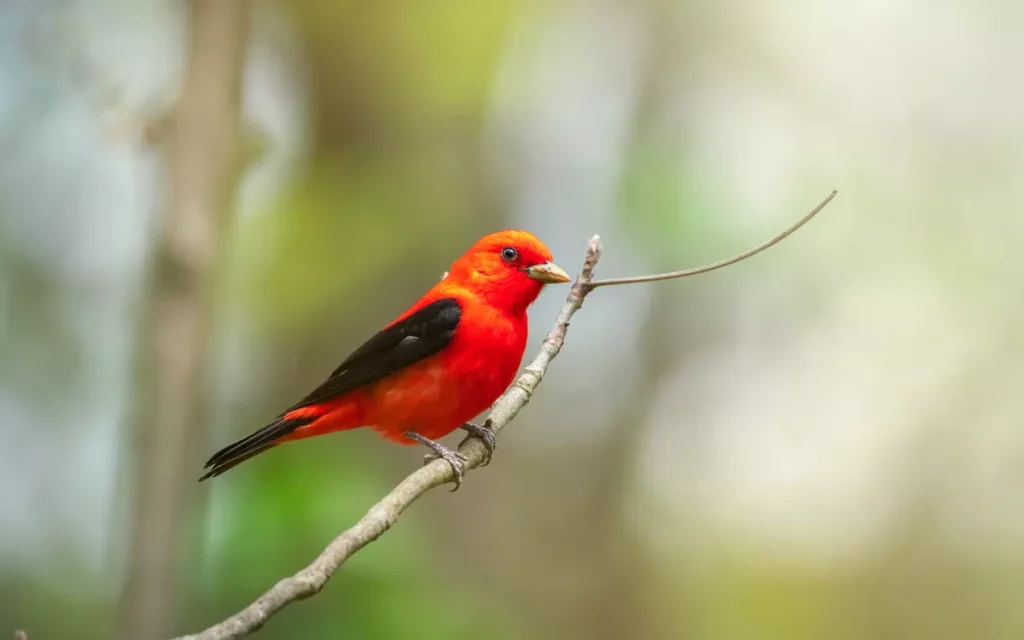
The Scarlet Tanager is a true showstopper with its brilliant red plumage that stands out against the foliage. Males wear their vivid red feathers during the breeding season, while females sport a more understated olive-yellow color.
These tanagers are known for their habit of foraging high in trees, making their vibrant presence known from above. In New Hampshire, Scarlet Tanagers lay about 3 to 4 eggs per clutch.
- Length: 6.3-6.7 in (16-17 cm)
- Weight: 0.8-1.3 oz (23-38 g)
- Wingspan: 9.8-11.4 in (25-29 cm)
Read also: 12 Owls In New Hampshire:Explore there beauty
27 Yellow Birds in New Hampshire:
New Hampshire, with its rich biodiversity, is home to a variety of bird species, some of which proudly flaunt shades of yellow in their plumage. These avian residents bring life and energy to the state’s natural habitats. Let’s take a closer look at some of the most notable yellow birds that call New Hampshire home:
1. Common Yellowthroat – Geothlypis trichas:

The Common Yellowthroat is a small songbird known for its distinctive mask-like markings and vibrant yellow throat. Found in various habitats, including wetlands and shrubby areas, this bird is a common sight in New Hampshire.
It’s a remarkable insect hunter and contributes to pest control. In a year, the Common Yellowthroat lays an average of 3-5 eggs. During the breeding season, it spends a significant amount of time in New Hampshire, contributing to the region’s ecosystem and charm.
- Length: 4.3-5.1 in (11-13 cm)
- Weight: 0.3-0.3 oz (9-10 g)
- Wingspan: 5.9-7.5 in (15-19 cm)
2.American Goldfinch – Spinus tristis:
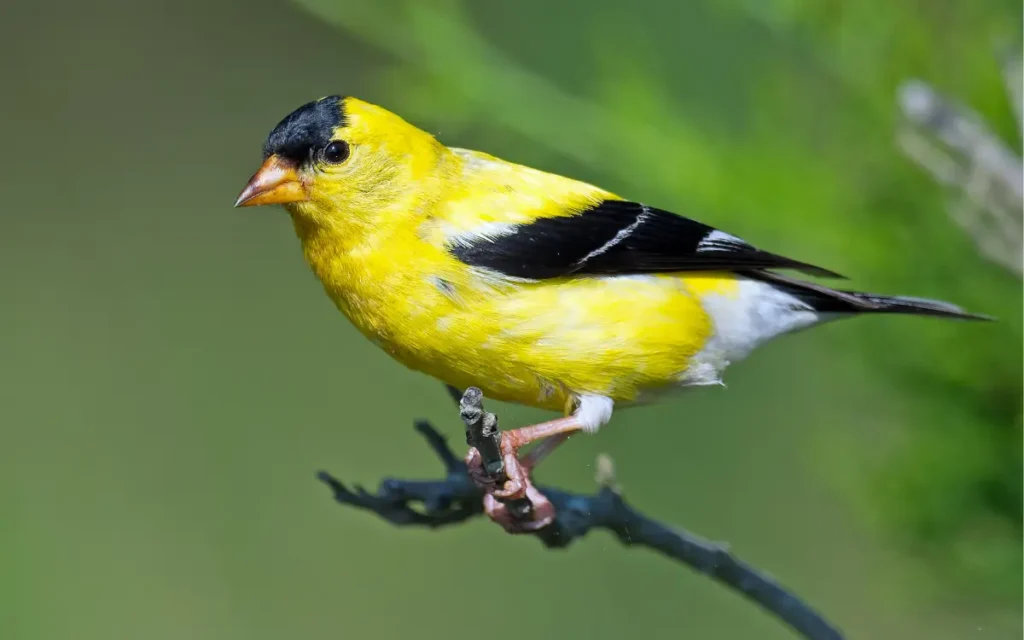
The American Goldfinch, often referred to as the “wild canary,” is a charming yellow bird that graces New Hampshire with its presence. Its cheerful song and bright plumage make it a favorite among bird enthusiasts.
This bird is known for its acrobatic flight and can be seen feeding on various seeds. Female goldfinches typically lay around 4-6 eggs in a clutch. Throughout the year, the American Goldfinch remains a common sight, enhancing the beauty of New Hampshire’s landscapes.
- Length: 4.3-5.1 in (11-13 cm)
- Weight: 0.4-0.7 oz (11-20 g)
- Wingspan: 7.5-8.7 in (19-22 cm)
3.Yellow-rumped Warbler – Setophaga coronata:
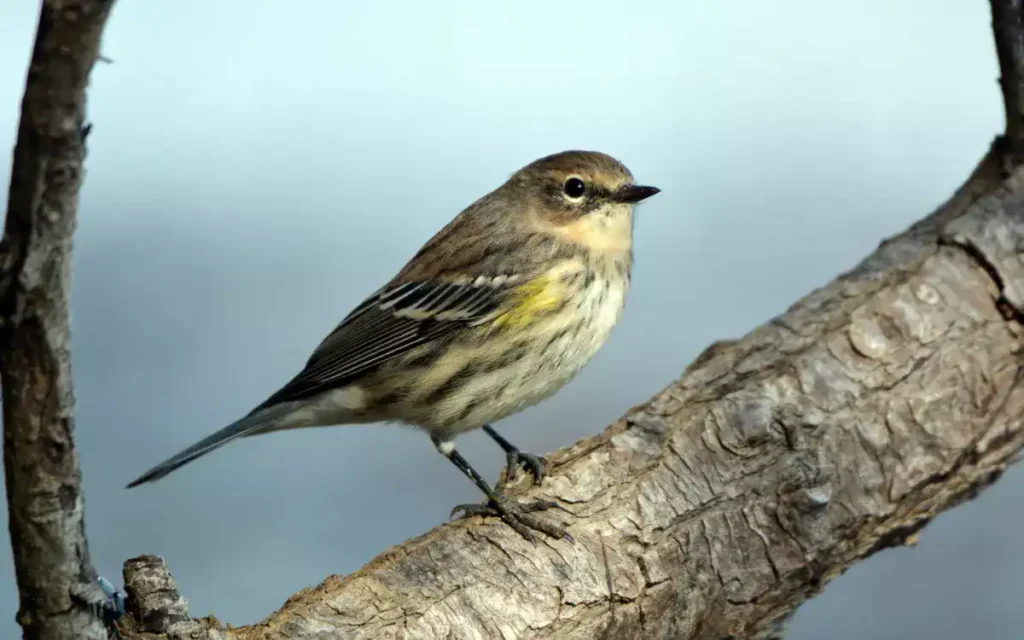
The Yellow-rumped Warbler, with its distinctive yellow patches on the rump, is a striking migratory bird in New Hampshire. It’s known for its adaptability to various habitats, including forests, woodlands, and even urban areas.
This warbler is an insectivore, contributing to the control of insect populations. It typically lays 3-5 eggs in a nest. During its migration, the Yellow-rumped Warbler spends a considerable amount of time in New Hampshire, making it a seasonal delight for birdwatchers.
- Length: 4.7-5.5 in (12-14 cm)
- Weight: 0.4-0.5 oz (12-13 g)
- Wingspan: 7.5-9.1 in (19-23 cm)
4. Northern Flicker – Colaptes auratus:
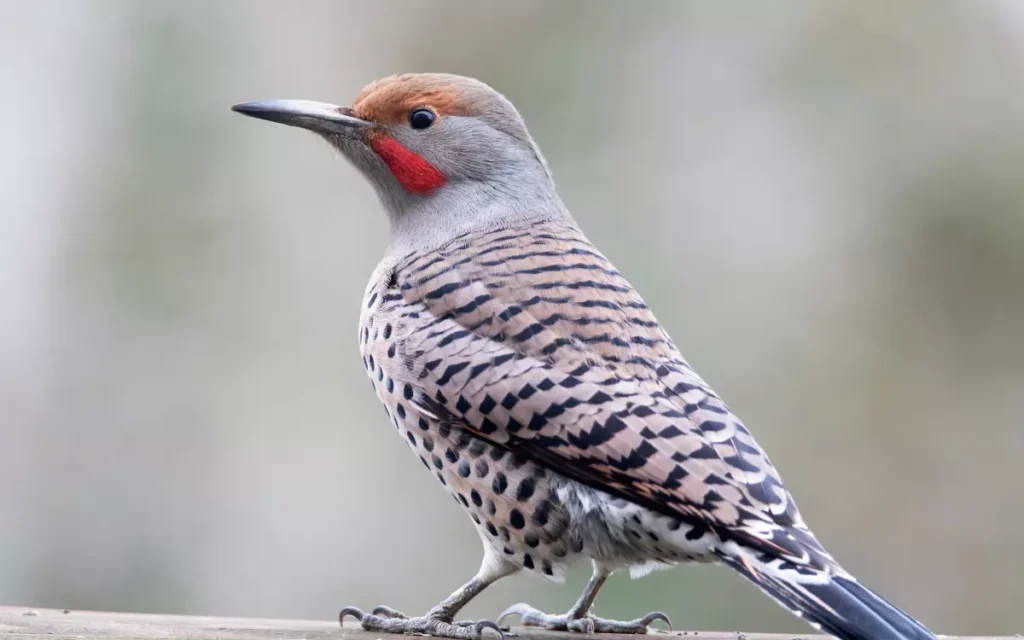
The Northern Flicker, with its distinct markings and vibrant yellow underparts, is a woodpecker species that adds a touch of elegance to New Hampshire’s woodlands.
These birds are known for their drumming sounds and ground foraging behavior. In a year, Northern Flickers typically lay 6-8 eggs. Their presence in New Hampshire’s forests and open areas enriches the region’s natural tapestry.
- Length: 11.0-12.2 in (28-31 cm)
- Weight: 3.9-5.6 oz (110-160 g)
- Wingspan: 16.5-20.1 in (42-51 cm
5. Pine Warbler – Setophaga pinus:
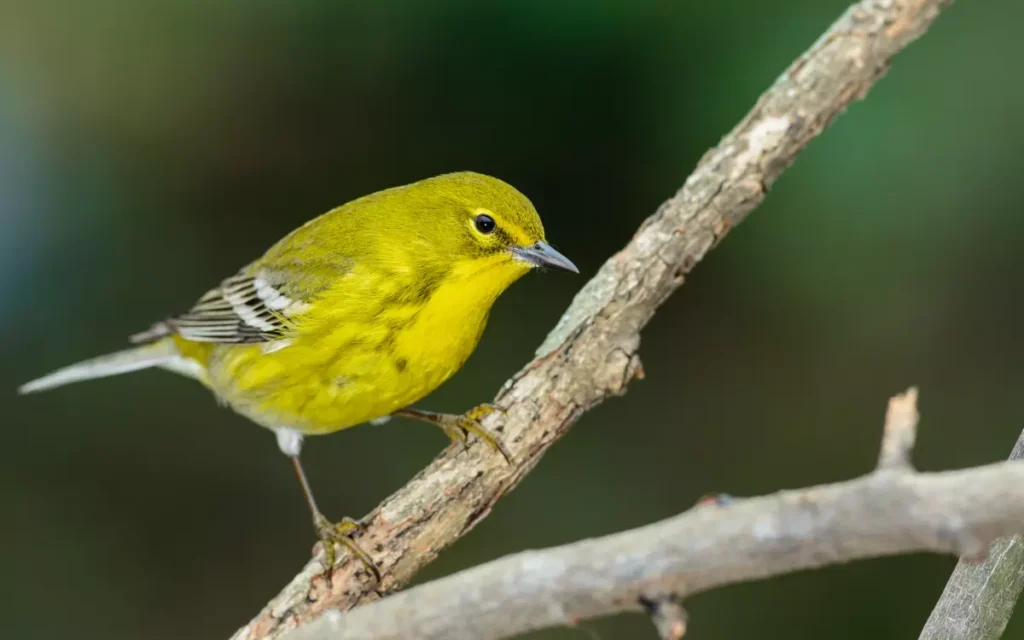
The Pine Warbler is a cheerful and melodious songbird that spends its summers in New Hampshire’s pine forests. With its yellow throat and streaked appearance, it’s a delight to observe.
Pine Warblers primarily feed on insects and are known for their ability to catch insects mid-air. They lay 3-5 eggs in a nest, contributing to the next generation of these lovely birds in the state.
- Length: 5.1-5.5 in (13-14 cm)
- Weight: 0.3-0.5 oz (9-15 g)
- Wingspan: 7.5-9.1 in (19-23 cm)
6. Black-throated Green Warbler – Setophaga virens:
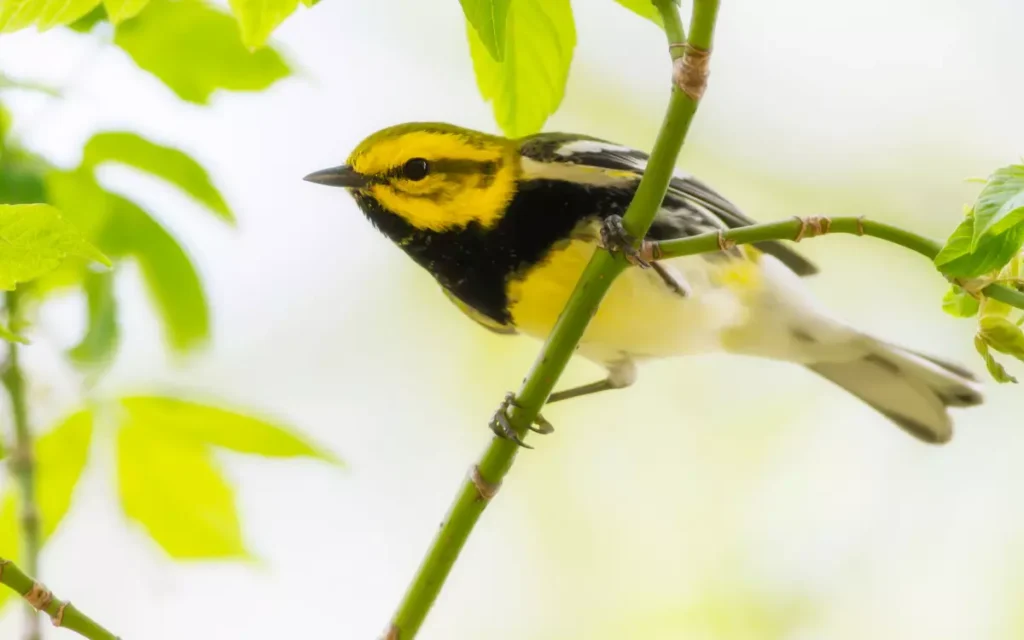
The Black-throated Green Warbler is a vibrant yellow bird with distinctive black markings on its face and throat. This warbler species thrives in New Hampshire’s lush forests and woodlands.
It’s an insectivore that actively searches for insects in trees and foliage. In a year, Black-throated Green Warblers lay around 3-5 eggs, playing a role in maintaining the ecological balance of the region.
- Length: 4.3-4.7 in (11-12 cm)
- Weight: 0.3-0.4 oz (7-11 g)
- Wingspan: 6.7-7.9 in (17-20 cm)
7. Yellow Warbler – Setophaga petechia:

The Yellow Warbler is aptly named, boasting a bright yellow plumage that’s hard to miss. It’s a common summer resident of New Hampshire, adding color and music to the state’s landscapes.
Yellow Warblers are insectivores and can often be spotted near water bodies. They typically lay 3-5 eggs, contributing to the next generation of these lovely warblers.
- Length: 4.7-5.1 in (12-13 cm)
- Weight: 0.3-0.4 oz (9-11 g)
- Wingspan: 6.3-7.9 in (16-20 cm)
8.Pine Siskin – Spinus pinus:

The Pine Siskin, with its subtle yellow streaks and distinctive beak, is a charming visitor to New Hampshire. These finches are known for their nomadic behavior, which can lead to varying numbers in different years.
Pine Siskins primarily feed on seeds and are frequent visitors to bird feeders. In a year, they lay around 3-5 eggs, contributing to the dynamic avian population of the state.
- Length: 4.3-5.5 in (11-14 cm)
- Weight: 0.4-0.6 oz (12-18 g)
- Wingspan: 7.1-8.7 in (18-22 cm)
9. Magnolia Warbler – Setophaga magnolia:
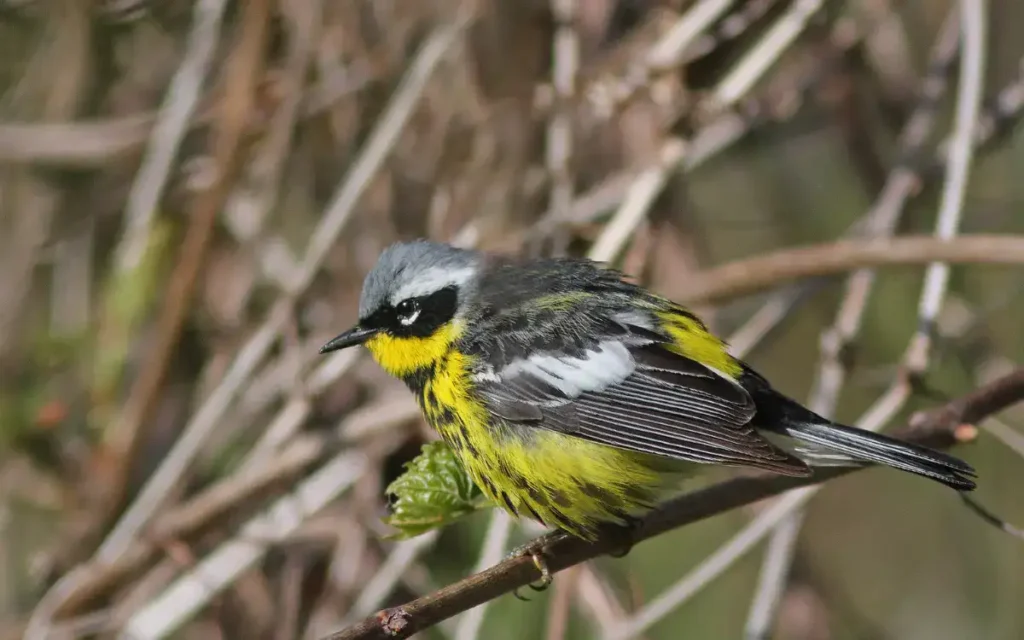
The Magnolia Warbler is a striking migratory bird known for its black necklace-like markings and vibrant yellow plumage. This warbler species graces New Hampshire during its migration, making it a seasonal treat for birdwatchers.
Magnolia Warblers primarily feed on insects and contribute to pest control. They typically lay 3-5 eggs, showcasing their role in New Hampshire’s ecological balance.
- Length: 4.3-5.1 in (11-13 cm)
- Weight: 0.2-0.5 oz (6-15 g)
- Wingspan: 6.3-7.9 in (16-20 cm)
10.Northern Parula – Setophaga americana:
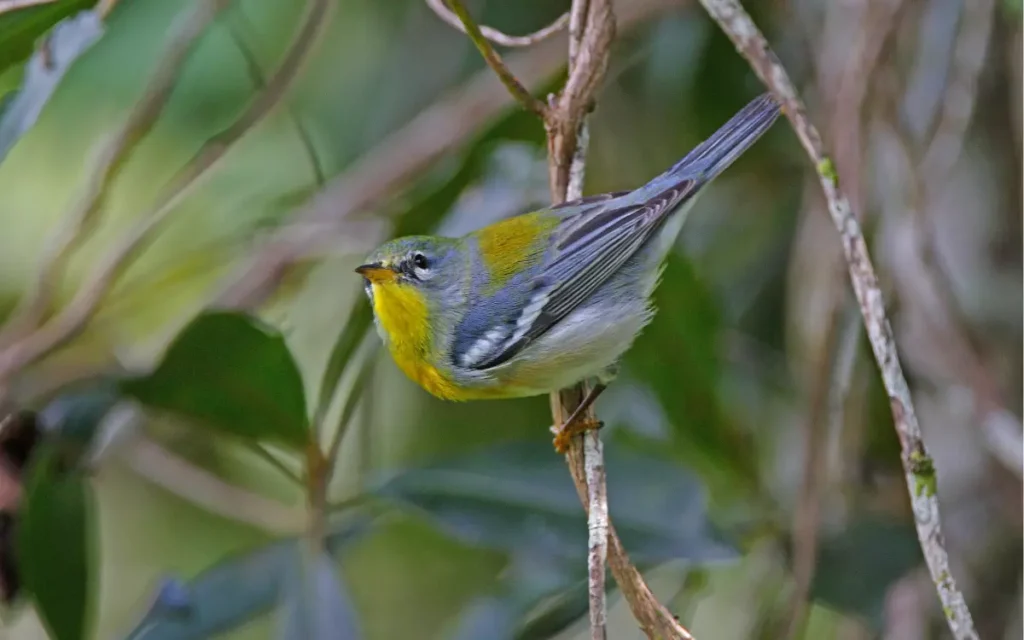
The Northern Parula, with its blue-gray upperparts and bright yellow throat, is a petite and eye-catching warbler species. This bird prefers habitats near water bodies, such as swamps and bogs.
It actively hunts insects and spiders among foliage. Northern Parulas typically lay 3-5 eggs, contributing to the avian diversity of New Hampshire.
- Length: 4.3-4.7 in (11-12 cm)
- Weight: 0.2-0.4 oz (5-11 g)
- Wingspan: 6.3-7.1 in (16-18 cm)
11. Nashville Warbler – Leiothlypis ruficapilla:
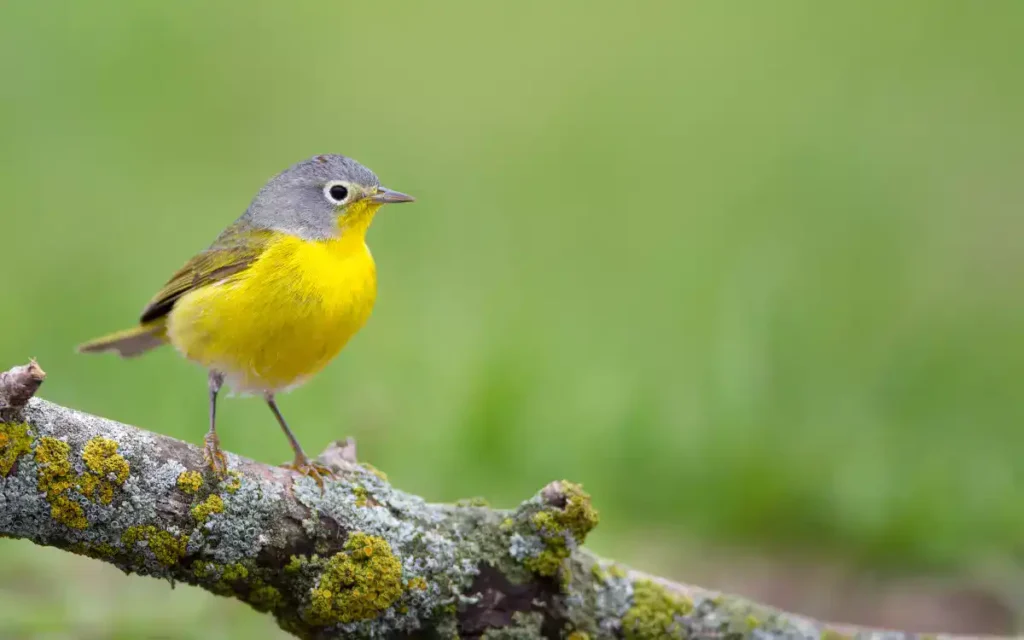
The Nashville Warbler, named after its discovery site in Nashville, Tennessee, is a charming migratory bird with a yellow crown and distinct eye-ring.
This warbler species is known for its foraging behavior, often hovering while searching for insects. Nashville Warblers lay around 4-5 eggs in a nest. Their brief presence in New Hampshire adds a touch of magic to the state’s birdwatching season.
- Length: 4.3-5.1 in (11-13 cm)
- Weight: 0.2-0.5 oz (6.7-13.9 g)
- Wingspan: 6.7-7.9 in (17-20 cm)
12.Canada Warbler – Cardellina canadensis:
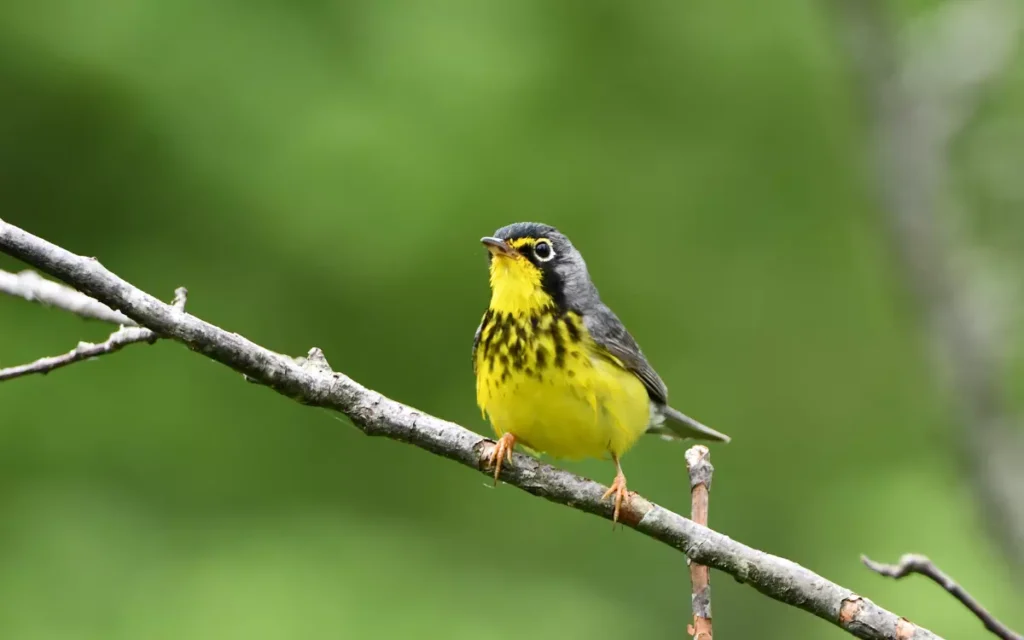
The Canada Warbler is a visually striking bird with a gray upper body and vibrant yellow underparts. This warbler species is often found in New Hampshire’s dense woodlands and shrubby areas.
They feed on insects and are known for their distinctive “chip-churr” call. In a year, Canada Warblers lay around 3-5 eggs, contributing to the ecological health of the state.
- Length: 4.7-5.9 in (12-15 cm)
- Weight: 0.3-0.5 oz (9-13 g)
- Wingspan: 6.7-8.7 in (17-22 cm)
13.Cape May Warbler – Setophaga tigrina:
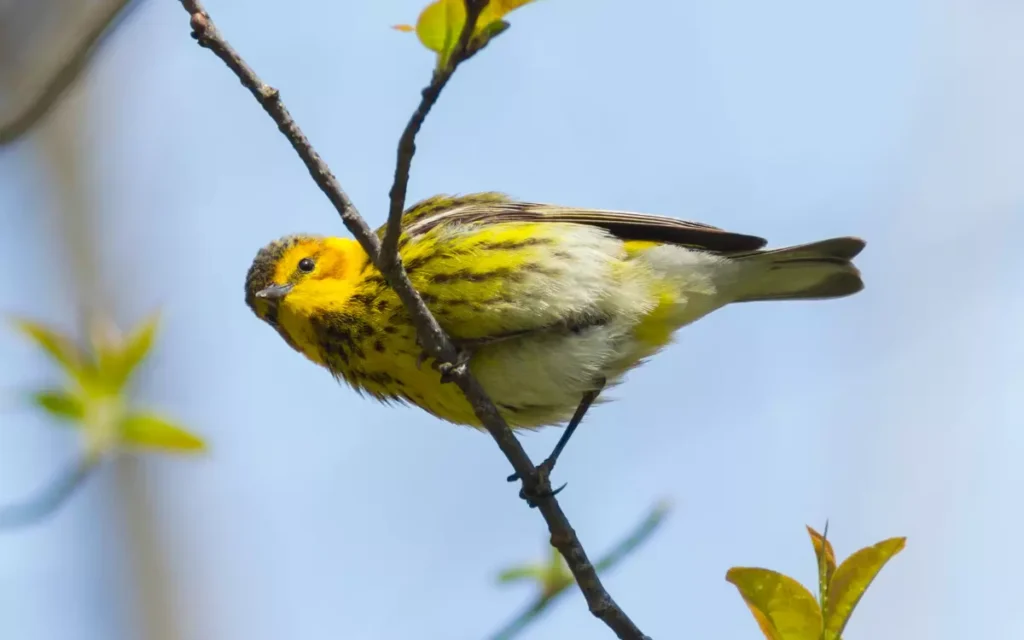
The Cape May Warbler is a dazzling migratory bird with a unique combination of colors, including yellow, green, and chestnut. This warbler species primarily feeds on nectar and insects, making it an essential pollinator.
Cape May Warblers lay around 4-5 eggs, showcasing their commitment to the next generation. Their presence in New Hampshire during migration adds a touch of beauty to the state’s landscapes.
- Length: 4.7-5.1 in (12-13 cm)
- Weight: 0.4-0.5 oz (10.2-15.2 g)
- Wingspan: 7.9-8.7 in (20-22 cm)
Similar post : Ducks In New Hampshire: A Comprehensive Guide
14.Cedar Waxwing – Bombycilla cedrorum:
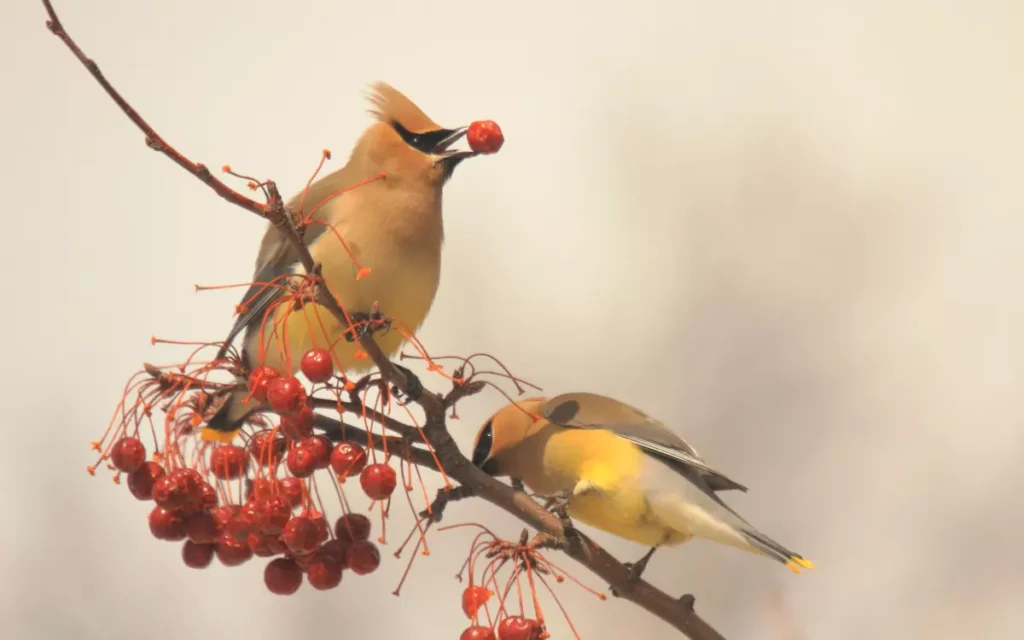
The Cedar Waxwing is a stunning bird with a sleek and silky appearance. Its yellow-tipped tail and subtle coloration make it a unique addition to New Hampshire’s avian diversity.
These birds are known for their social nature and tendency to gather in large flocks. They feed on fruits and insects and contribute to seed dispersal. Cedar Waxwings lay 3-5 eggs in a nest. Their intermittent presence in New Hampshire adds an element of surprise to the state’s birdwatching experience.
- Length: 5.5-6.7 in (14-17 cm)
- Weight: 1.1 oz (32 g)
- Wingspan: 8.7-11.8 in (22-30 cm)
15.White-eyed Vireo – Vireo griseus:
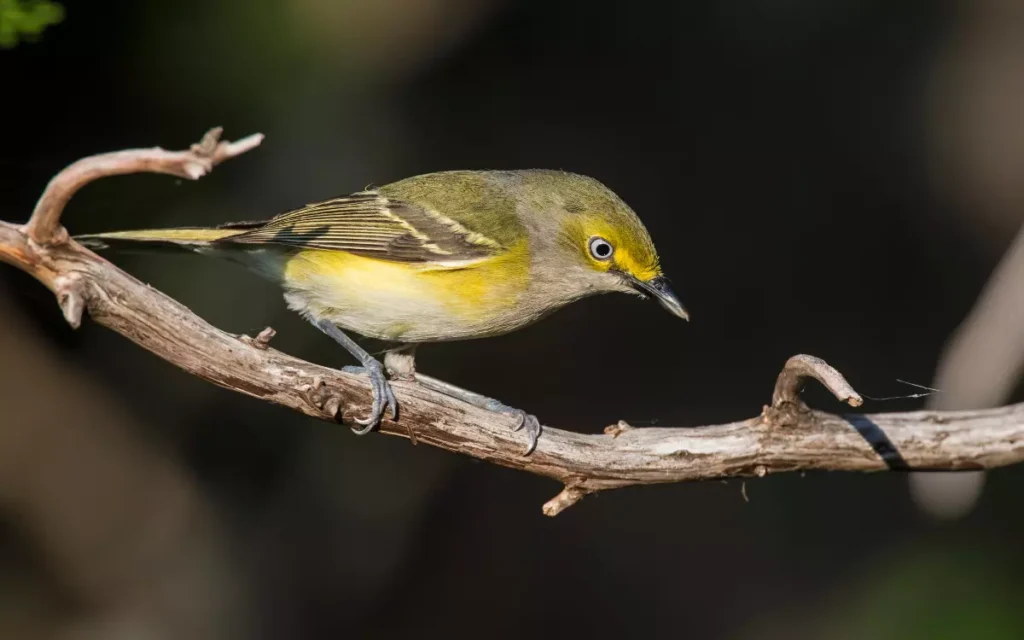
The White-eyed Vireo is a small, vibrant bird with striking orange-yellow plumage on its flanks. It’s known for its distinctive call, which resembles a conversation between two individuals.
This charming bird lays around 3 to 5 eggs per clutch, and during the breeding season, it spends a significant amount of time in New Hampshire’s wooded areas, contributing to the region’s avian diversity.
- Length: 4.3-5.1 in (11-13 cm)
- Weight: 0.3-0.5 oz (10-14 g)
- Wingspan: 6.7 in (17 cm)
16.Western Kingbird – Tyrannus verticalis:
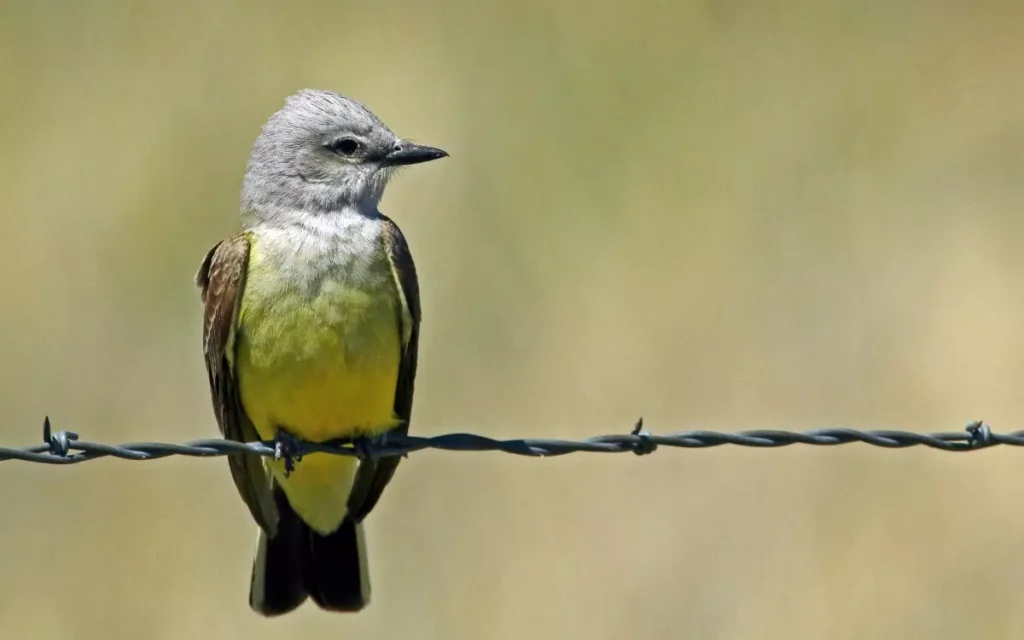
The Western Kingbird is a lively bird with a lemon-yellow belly and orange patches on its crown. This bird is a skilled insect hunter, often perching on high vantage points to spot its prey.
During the nesting season, it lays approximately 3 to 4 eggs and invests a considerable portion of the year in New Hampshire, especially in open fields and grasslands.
- Length: 7.9-9.4 in (20-24 cm)
- Weight: 1.3-1.6 oz (37-46 g)
- Wingspan: 15.0-16.1 in (38-41 cm)
17.Evening Grosbeak – Coccothraustes vespertinus:
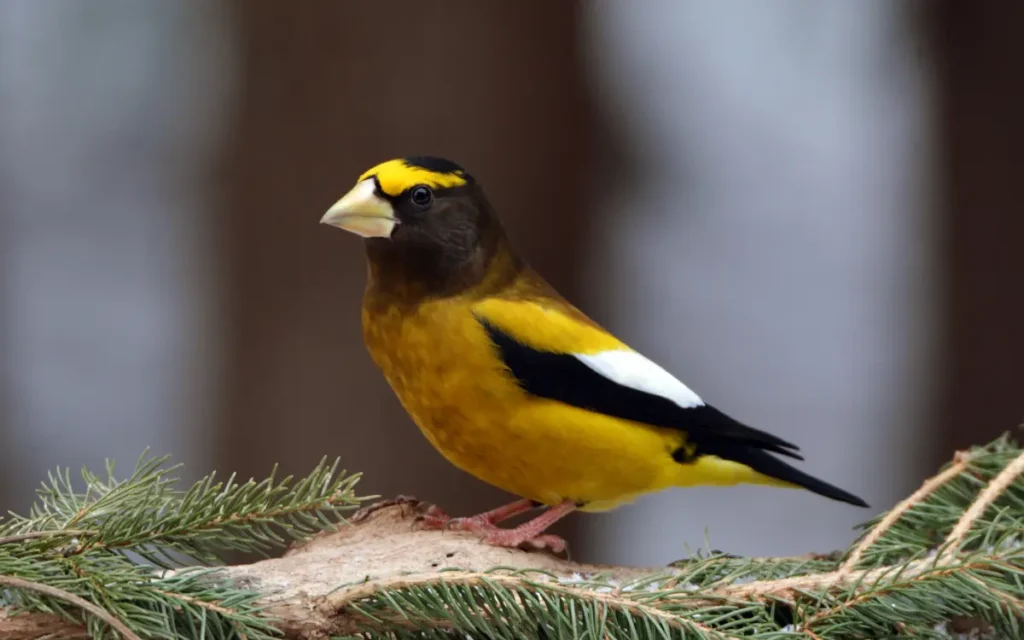
The Evening Grosbeak boasts a striking combination of vibrant yellow and black feathers, with touches of orange on its head and wings. Known for its hearty appetite, this bird is a frequent visitor to bird feeders during the colder months.
The Evening Grosbeak’s nesting habits involve laying 2 to 4 eggs, and it spends a substantial amount of time in New Hampshire, providing cheerful company to bird enthusiasts.
- Length: 6.3-7.1 in (16-18 cm)
- Weight: 1.9-2.6 oz (53-74 g)
- Wingspan: 11.8-14.2 in (30-36 cm)
18.Palm Warbler – Setophaga palmarum:
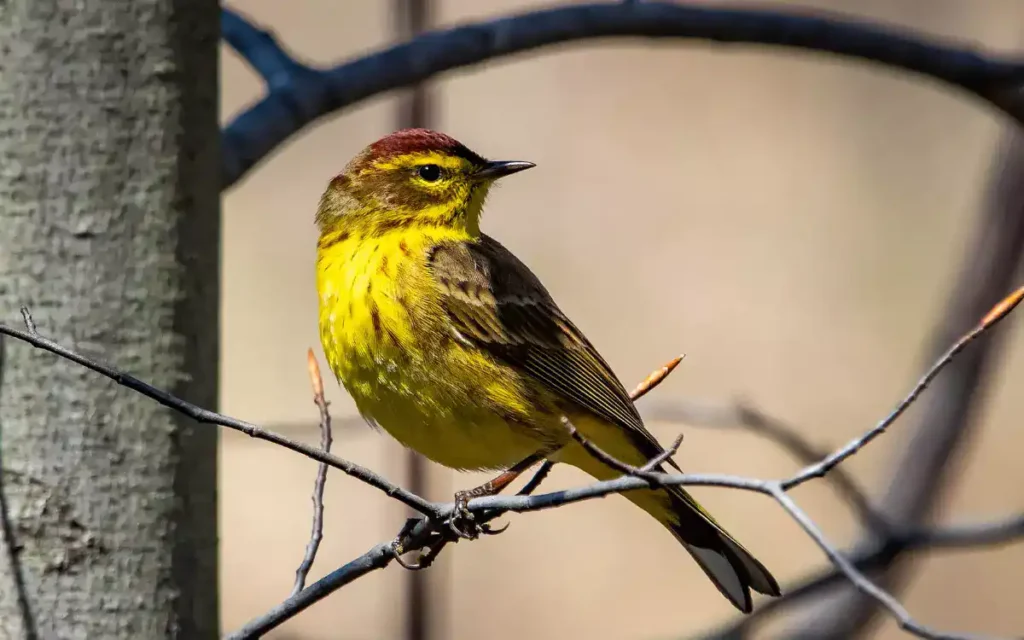
The Palm Warbler showcases a mix of olive-green and bright yellow hues, making it an eye-catching addition to New Hampshire’s avian residents.
It’s a ground-foraging bird that’s often spotted wagging its tail while searching for insects. This warbler typically lays 4 to 5 eggs during the breeding season and migrates through New Hampshire during its fall and spring journeys.
- Length: 4.7-5.5 in (12-14 cm)
- Weight: 0.3-0.5 oz (7-13 g)
- Wingspan: 7.9-8.3 in (20-21 cm)
19.Prairie Warbler – Setophaga discolor:
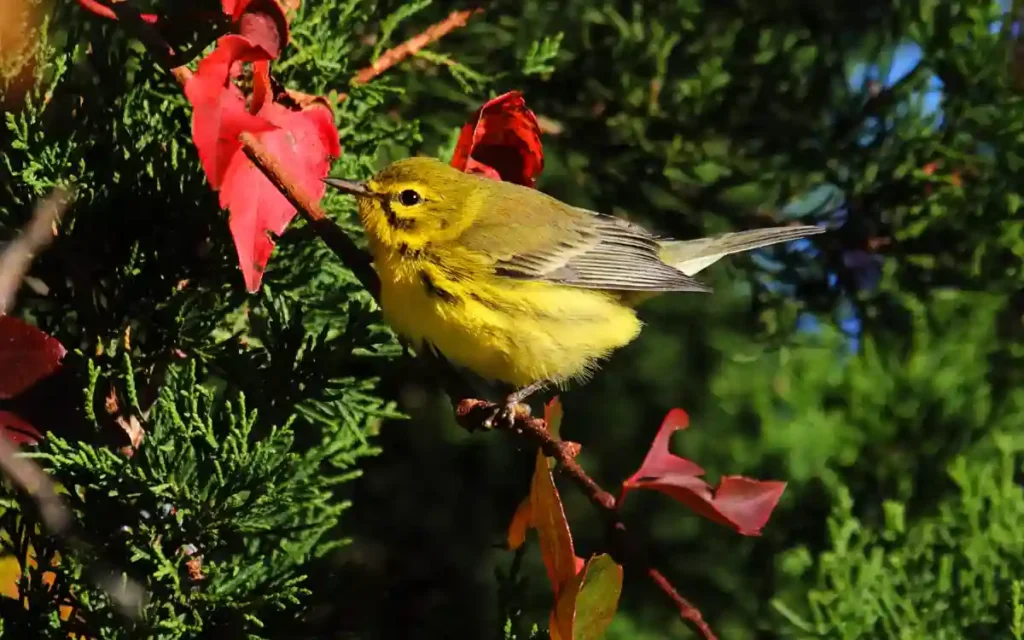
The Prairie Warbler is a lively bird with a mix of yellow, black, and streaks of orange on its face. Its distinct song is often associated with grassy habitats and shrublands.
This warbler typically lays 3 to 5 eggs and spends a part of the year in New Hampshire, contributing to the state’s rich avian diversity.
- Length: 4.3 in (11 cm)
- Weight: 0.2-0.3 oz (6.4-8.8 g)
- Wingspan: 7 in (18 cm
20.Wilson’s Warbler – Cardellina pusilla:

With bright yellow plumage and a black cap, the Wilson’s Warbler is an instantly recognizable bird. Its cheerful presence and melodious song make it a delight to encounter.
This warbler lays around 4 to 5 eggs per clutch and spends a portion of its time in New Hampshire’s woodlands and wet areas.
- Length: 3.9-4.7 in (10-12 cm)
- Weight: 0.2-0.3 oz (5-10 g)
- Wingspan: 5.5-6.7 in (14-17 cm)
21.Great Crested Flycatcher – Myiarchus crinitus:
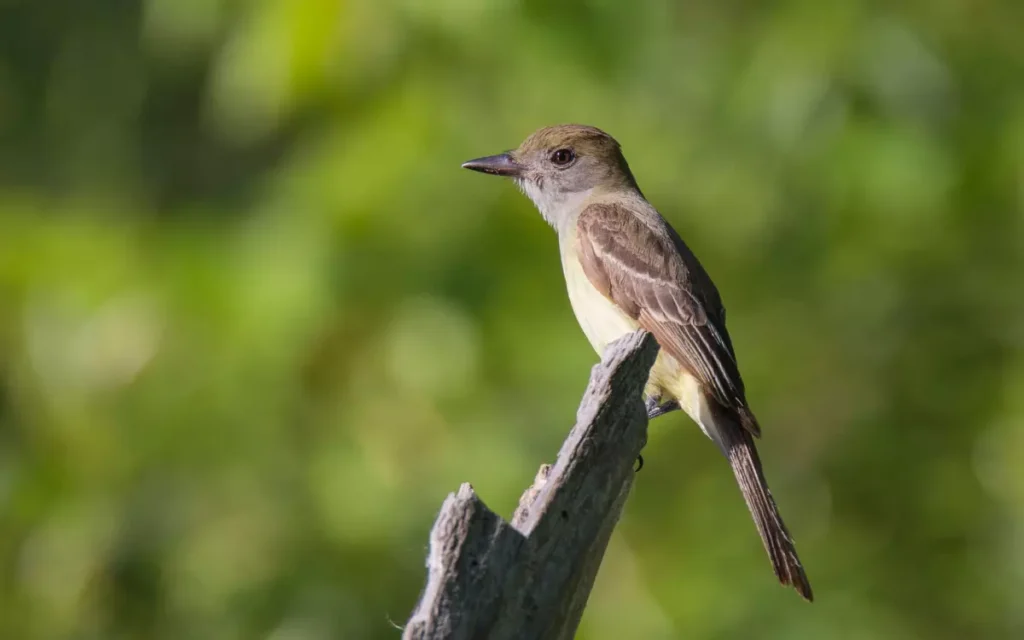
The Great Crested Flycatcher is characterized by its lemon-yellow belly and striking rusty-orange tail.
It’s known for its unique call that sounds like “wheep!” This flycatcher lays about 4 to 5 eggs and is often seen in New Hampshire’s wooded habitats, adding its distinctive charm to the birding scene.
- Length: 6.7-8.3 in (17-21 cm)
- Weight: 0.9-1.4 oz (27-40 g)
- Wingspan: 13.4 in (34 cm)
22.Eastern Meadowlark – Sturnella magna:

The Eastern Meadowlark is known for its bright yellow belly and intricate black markings on its chest. Its melodious song is a common sound in grasslands and meadows.
This bird typically lays around 3 to 6 eggs and spends a part of its time in New Hampshire, adding a touch of color to the state’s open landscapes.
- Length: 7.5-10.2 in (19-26 cm)
- Weight: 3.2-5.3 oz (90-150 g)
- Wingspan: 13.8-15.8 in (35-40 cm)
23. Dickcissel – Spiza americana:

The Dickcissel is a striking bird with a mix of yellow, black, and white feathers. Its distinctive call resembles its name, making it easily identifiable by sound. This bird lays around 3 to 5 eggs and is occasionally spotted in New Hampshire during its migration periods.
- Length: 5.5-6.3 in (14-16 cm)
- Weight: 0.9-1.4 oz (25.6-38.4 g)
- Wingspan: 9.8-10.2 in (24.8-26 cm)
24.Western Tanager – Piranga ludoviciana:
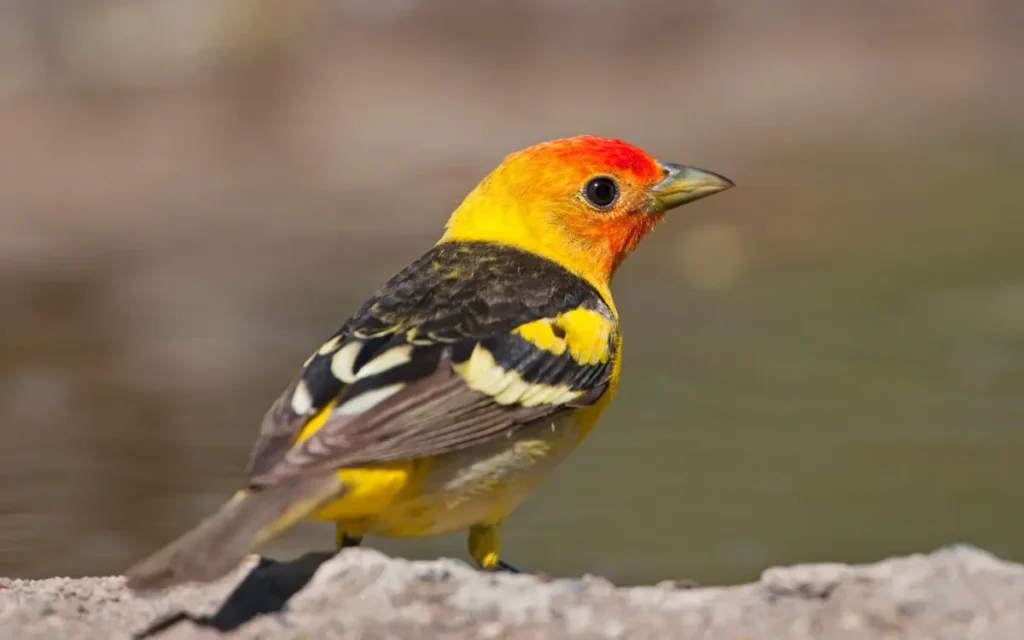
The Western Tanager is a vibrant bird with a reddish-orange head and bright yellow body. Its presence adds a burst of color to New Hampshire’s forests. This tanager lays about 3 to 5 eggs and can be observed during its migratory passages in the state.
- Length: 6.3-7.5 in (16-19 cm)
- Weight: 0.8-1.3 oz (24-36 g)
- Wingspan: 11.5 in (29 cm).
25.Hooded Warbler – Setophaga citrina:
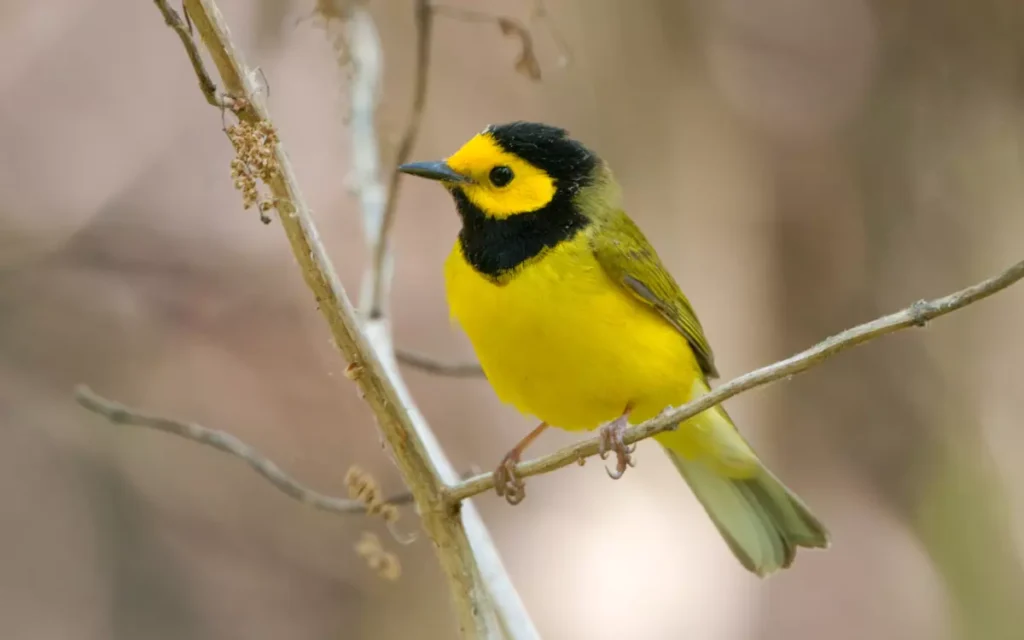
The Hooded Warbler boasts a striking contrast between its black hood and vibrant yellow body. Its melodious song echoes through wooded areas, making it a cherished sound for bird enthusiasts. This warbler typically lays around 3 to 4 eggs and spends part of its time in New Hampshire’s dense forests.
- Length: 5.1 in (13 cm)
- Weight: 0.3-0.4 oz (9-12 g)
- Wingspan: 6.9 in (17.5 cm)
26.Orchard Oriole (Female) – Icterus spurius:

The female Orchard Oriole showcases a blend of yellow and green hues, with subtle orange accents on its wings.
It’s a secretive bird that often nests in dense foliage. This oriole lays approximately 3 to 4 eggs and makes brief appearances in New Hampshire during migration.
- Length: 5.9-7.1 in (15-18 cm)
- Weight: 0.6-1.0 oz (16-28 g)
- Wingspan: 9.8 in (25 cm)
27. Yellow-throated Vireo – Vireo flavifrons:
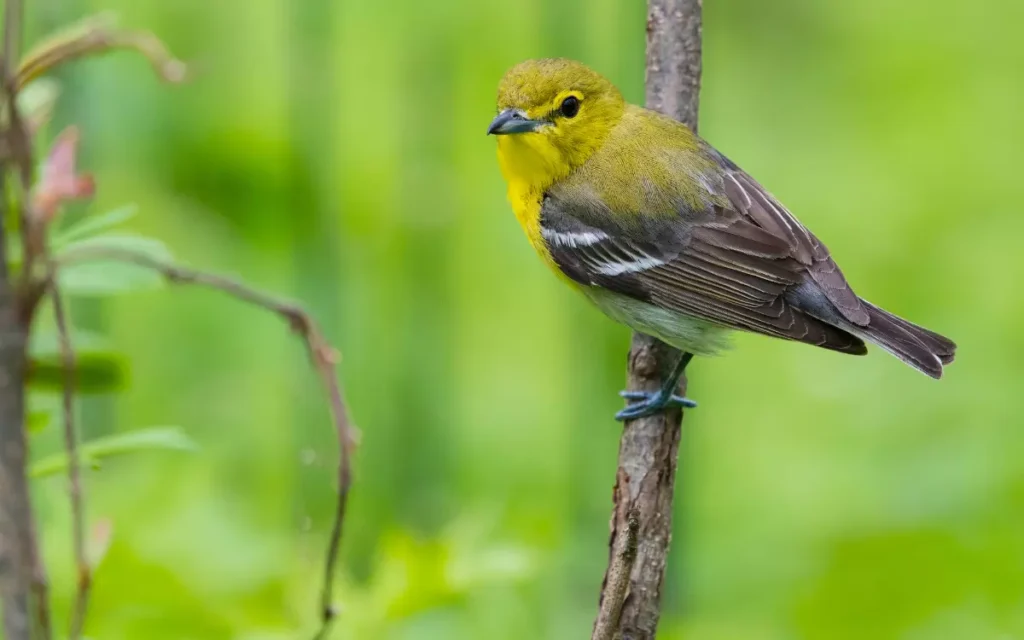
The Yellow-throated Vireo is recognized by its lemon-yellow throat and striking white spectacles around its eyes. Its intricate song fills the air in New Hampshire’s woodlands. This vireo typically lays around 3 to 4 eggs and spends part of the year in the state.
- Length: 5.1-5.9 in (13-15 cm)
- Weight: 0.5-0.7 oz (15-21 g)
- Wingspan: 9.1 in (23 cm)
Frequently Asked Questions:
Q: How can I attract red, orange, and yellow birds to my backyard?
A: Creating a bird-friendly environment with native plants, feeders, and water sources can attract these colorful birds to your yard. Patience is key as they may take time to discover and trust the new habitat.
Q: Do these birds migrate?
A: Many of the red, orange, and yellow birds in New Hampshire are migratory. They travel south during the colder months and return in spring, following their preferred feeding and nesting grounds.
Q: Are there any endangered species among these birds?
A: Yes, the Kirtland’s warbler, with its distinctive yellow plumage, is an endangered species that passes through New Hampshire during migration. Conservation efforts are crucial to its survival.
Q: How can I differentiate between similar-looking species?
A: Pay attention to specific markings, such as beak shape, wing patterns, and size. Using field guides or mobile apps designed for bird identification can be immensely helpful.
Q: What role do these birds play in the ecosystem?
A: Apart from their aesthetic value, these birds contribute to ecosystem balance by controlling insect populations, aiding in pollination, and dispersing plant seeds.
Conclusion:
The Red, Orange, & Yellow Birds of New Hampshire are truly remarkable. They make our state more colorful and lively. Keep an eye out for these bright birds the next time you examine our beautiful outdoors.

